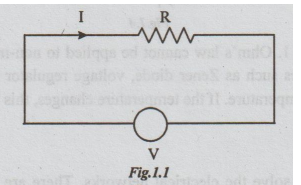Electric Circuit Analysis: Unit I: b. Basic circuits analysis
Statement and Limitations of ohm's law
The ratio between the potential difference across two terminals of a conductor and the current through it remains constant, when the physical conditions of the conductor remain unchanged. Here the physical condition is the temperature.
Unit - I
BASIC
CIRCUITS ANALYSIS
OHM'S LAW AND ITS LIMITATIONS
Statement:
The
ratio between the potential difference across two terminals of a conductor and
the current through it remains constant, when the physical conditions of the
conductor remain unchanged. Here the physical condition is the temperature.
Mathematically,
V/I
= constant
Or
V / I = R
V
= I × R
This
is the ohm's law. By knowing any two quantities, the third can be calculated.

P
= VI = I2R= V2/R
Note
1: Take example of the resistor in the Fig. (1.3).
Terminal A is connected to +ve and B connected to -ve. If you interchange the
terminals, the same current will flow, but in the opposite direction. Such
element which will have same property for either direction of current is called
bidirectional or (bilateral) element i.e., resistor is example of bilateral
element.

Note
2: Take example of a diode. When it is forward-biased,
the current is higher, and when it is reversed-biased, the current is very low.
So when the polarities of the applied voltage are changed, the direction of
current changes and also its strength. That means the resistance offered by the
diode is different depending upon the direction of flow of current. Such
element whose properties change, when the direction of current changes is
called unilateral or unidirectional element.

Note 3: Taking current along X axis and voltage along Y axis, a graph can be plotted to represent ohm's law. This will be a straight line passing through origin. The slope of this line represents the resistance.

Limitations
of ohm's law: 1. Ohm's law cannot be applied to
non-metallic conductors 2. It cannot be applied to non-linear devices such as
Zener diode, voltage regulator (VR) tubes etc. 3. Ohm's law holds good only for
constant temperature. If the temperature changes, this law cannot be applied.
Electric Circuit Analysis: Unit I: b. Basic circuits analysis : Tag: : - Statement and Limitations of ohm's law
Related Topics
Related Subjects
Electric Circuit Analysis
EE3251 2nd Semester 2021 Regulation | 2nd Semester EEE Dept 2021 Regulation
